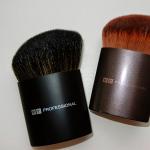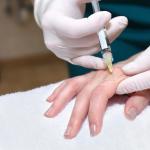Why does gray hair appear and how to deal with it?
Previously, the appearance of gray hair always occurred in adulthood and was a sign of wisdom and importance. A modern person, exposed to frequent stress and the influence of unfavorable environmental factors, may notice the appearance of gray hair at the age of 20-30. Why does gray hair appear? How to prevent its occurrence? And is this process always physiological?
Typically, the first gray hair appears at the age of 35; over time, bleached hair becomes more numerous, and after about 10 years it begins to predominate over natural-colored hair. Sometimes their appearance can occur at a younger age. Such a process may indicate the development of various pathologies and always becomes a signal of concern. Despite the fact that almost no one can prevent the appearance of gray hair, there are factors in this physiological process that can be influenced and prolong the youth and beauty of your hair. In this article we will introduce you to the causes of gray hair and methods to combat it.
Why does gray hair appear?
In order to better understand the process of gray hair formation, let's get acquainted with the physiology of hair. In humans, hair color is determined by special pigments: pheomelanin, ossimelanin, eumelanin and a group of triochromes. They are varieties of such a pigment, so familiar to everyone from school, which is produced by special cells - melanocytes, located in the basal (lower) layer of the epidermis and in the hair follicles. Melanin synthesis occurs under the influence of mediators of the sympathetic nervous system, hormones, pituitary gland (melanocyte-stimulating hormone, ACTH and β-lipotropin) and sex hormones.
Eumelanin determines dark brown or black hair color, ossimelanin - light, pheomelanin - henna shades, and the triochrome group - red shades. The mixing of these pigments in different proportions determines the hair color of each person. They color the keratin that makes up the hair shafts, and the intensity of their shade depends on how much melanin each hair follicle receives. The combination and volume of eumelanin, triochromes, ossimelanin and pheomelanin are determined genetically. This is how a wide range of hair shades appears: chestnut, black, copper, golden, red...
Melanocytes begin to work even before the birth of a child and gradually regress with age. Every 10 years after the age of 30, their function fades by 10-20%, and it is depending on the degree of their repression that gray hair appears in the head of hair - almost colorless hair with a lack of pigment in keratin. When all the melanocytes that supply melanin to the hair shaft die, all hair becomes completely gray.
Not long ago, European scientists discovered another reason for the appearance of gray hair. As it turns out, as we age, hair follicles can produce small amounts of hydrogen peroxide, which interacts with pigments and discolors them. This process can be neutralized by catalase, a special enzyme. With age, this enzyme becomes less and less, and the peroxide produced and accumulated by the follicles discolors the hair shaft from the inside. As a result, the hair becomes colorless.
Causes of gray hair
Physiological graying is associated with the natural aging of melanocytes, and the appearance of early gray hair may be due to their death or decreased activity due to hormonal disorders. As a result, the hair loses its pigment, acquires a porous structure, and the resulting air “layers” give it a silvery-white hue.
Many different factors can change your hair color. They can be divided into:
- external: unfavorable environmental conditions;
- internal: genetic characteristics, age, stressful situations, etc.
The causes of gray hair can be:
- poor ecology: contributes to the development of diseases and premature aging;
- hereditary predisposition: most people experience gray hair at the same age as their parents;
- prolonged depression and chronic stress: nervous breakdowns provoke the release of large amounts of adrenaline into the blood, which breaks the connection between melanin and keratin in the hair follicles; in addition, nervous overstrain causes weakened immunity and premature aging;
- race: gray hair appears earlier in Europoids and Mongoloids, and later in Negroids;
- diseases of the thyroid gland: the pathology of this endocrine organ leads to;
- conditions associated with pigmentation disorders: albinism, and some other diseases - gray strands can appear at any age;
- and lack of vitamins A, group B, C, minerals copper, manganese, iron and selenium: cause pathology of internal organs and disrupt the normal blood supply to all tissues of the body;
- Poor nutrition: leads to a deficiency of vitamins and minerals that ensure the normal functioning of the entire body;
- diseases of the digestive system and kidneys lead to disruption of metabolic processes in the body;
- skin diseases: herpetic or erysipelas, alopecia areata;
- hormonal imbalance: unstable hormone levels (for example, during pregnancy, after childbirth, with polycystic ovary syndrome or during menopause) can provoke stressful situations, endocrine disorders of the thyroid gland and exhaustion of the nervous system;
- : antibodies produced in the body destroy melanocytes and lead to a lack of hair pigmentation;
- bad habits: cause many diseases, hormonal imbalance and premature aging;
- taking medications: long-term and frequent use of certain medications (especially antibiotics, Rezoquine, Chloroquine, Hydroquinone and phenylthiourea) negatively affects immunity and metabolism;
- improper care of hair and scalp: using hot water, staying in the sun or in the cold without a hat, using aggressive care, styling and coloring products have a detrimental effect on the scalp and contribute to the weakening of hair pigmentation.
Characteristics of gray hair
After losing most of the pigment, the hair shafts become ash-gray, and after losing all the melanin, they turn white. In smokers, gray hair with a yellowish tint can be observed.
In addition to bleaching, gray hair loses both its usual properties and normal structure, since melanin not only colors the hair shaft, but also protects it from external adverse factors (for example, from exposure to ultraviolet radiation) and gives it elasticity and strength. This is why, after graying, hair becomes stiffer, brittle, dry, split and unruly when styled. In some cases, they begin to tangle and curl.
How to prevent the appearance of gray hair?
Doctors and cosmetologists have not yet learned how to return gray hair to its previous shade, and the “fight” against gray hair that has already appeared can only consist of dyeing hair with special dyes with 3rd degree of durability. However, it is possible to prevent early graying, get rid of single gray hairs and stop the progression of this process if you follow a number of simple rules.
Nutrition
 Proper nutrition will help keep your hair beautiful longer.
Proper nutrition will help keep your hair beautiful longer. Balancing our diet is one of the key factors that contribute to maintaining youth, health and beauty. To prevent graying, you should include foods rich in these six minerals in your diet:
- calcium– dairy products, soy, nuts, wheat, greens;
- copper– eggs, beans, green vegetables, almonds, mushrooms, pumpkin seeds;
- zinc– mushrooms, whole grains, oysters, egg yolks;
- chromium– oysters, wine, wheat bread;
- iron– seaweed, apples, legumes, buckwheat, beef, eggs, cocoa;
- iodine– black currant, sea fish, persimmon, seaweed.
For normal hair pigmentation, your daily diet should include foods high in the following vitamins:
- beta carotene– carrots, cabbage, fish, spinach, liver;
- E– almonds, peanuts, hazelnuts, sea buckthorn, dried apricots, pistachios, wheat, spinach, viburnum;
- WITH– citrus fruits, rose hips, kiwi, apples, berries, bell peppers, wild garlic, Brussels sprouts;
- group B (B3, B5, B6, B7, B10 and B12)– pine nuts, cashews, lentils, pork, rabbit, mackerel, sardines, liver, champignons, eggs, dairy products, beans, walnuts, sea buckthorn;
- folic acid– liver, peanuts, walnuts, beans, spinach, hazelnuts, broccoli, wild garlic;
- inositol– melon, nuts, meat, prunes, kiwi, legumes.
The above minerals and vitamins are important not only for normal hair pigmentation, but are also necessary for maintaining hair health. Daily inclusion of foods rich in them in your diet will improve your hair and make it shiny and strong.
In addition to these vitamins and minerals, your diet should include foods high in Omega-3 and Omega-6 fatty acids:
- flax seeds;
- fish fat;
- salmon;
- olive oil;
- oats;
- almonds, etc.
All these beneficial substances can be taken in the form of dietary supplements and vitamin-mineral complexes:
- Melan+ for men and Melan+ for women;
- Neurobex;
- Complements selenium.
They should be taken with meals and with plenty of water. These medications should not be taken after heavy meals, as in such cases they will not be fully absorbed.
Drinking regime
Hair follicles are extremely sensitive to lack of fluid in the body. Lack of water impedes the intake and absorption of nutrients and can cause graying of hair. That is why, to maintain their health, it is necessary to drink 1.5-2 liters of water daily.
Proper hair care

When the first gray hair appears, you should pay close attention to hair care:
- Wash your hair with water at a comfortable temperature.
- Use shampoos, conditioners and masks that contain non-aggressive detergent ingredients, vitamins, natural extracts and nutrients.
- Minimize the use of hair dryers, curling irons, straighteners, aggressive dyes and styling products.
- Wear hats in hot and frosty weather.
- Avoid styling that disrupts normal blood circulation in the scalp: ponytails, braids, the use of hairpins, elastic bands, etc.
Salon treatments
The appearance of gray hair can be stopped using the following procedures performed in beauty salons:
- laser therapy;
- plasma lifting;
- ultrasound therapy;
- microelementary mesotherapy.
Hardware hair treatment methods can be supplemented by the use of nourishing masks and vitamin serums:
- Dikson POLIPANT COMPLEX;
- Dercos Technique Vichy;
- Intensive Energizing Complex, etc.
Folk remedies
To prevent the appearance of gray hair, you can use various folk remedies that help restore their health.
Garlic mask
Pass the garlic through a press. Add a little burdock oil to the resulting paste and rub into the hair roots with gentle massaging movements. The head should be wrapped in a warm towel. Rinse off the mask after 10-15 minutes, rinse hair with shampoo. Repeat the procedure 2 times a week.
Applications with infusion of burdock roots
Pour 2 tablespoons of chopped burdock roots and 2 teaspoons of dill fruit into 0.5 liters of boiling water and leave for about 3 hours. Rub into clean scalp 2 times during the day. The procedure should be repeated daily for 3 months.
Wheat germ oil mask
Mix 30 ml of wheat germ oil with 7 drops of lavender, rose and sandalwood oil. Apply with massaging movements to the scalp, wrap and keep for about 1-2 hours. Wash off with shampoo. The mask should be applied 2 times a week for 2-3 months.
Before using these and other folk remedies, you should make sure that there is no allergic reaction to the components of the recipe.






